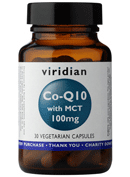COQ10
COQ10, also known as CoenzymeQ10 or Ubiquinone is an essential nutrient that is required by every cell in our body. COQ10 is hailed as the ‘anti ageing’ enzyme due to its ability to act as a potent anti-oxidant protecting our cells from free radical damage. It is also a key nutrient in energy production.
Our bodies make small amounts of COQ10, but deficiency of this nutrient is common. Recent research by Oregon state University (1) has demonstrated that we produce less COQ10 as we age therefore it is essential we consume this nutrient in our diet.
Functions of COQ10
- Energy production: COQ10 is required for energy production. It assists the conversion of food into energy within our cells.
- Digestion of food: COQ10 stimulates digestive enzymes in our pancreas. Digestive enzymes break apart our food and allows our bodies to absorb vitamins and minerals from food
- Antioxidant: COQ10 helps to fight free radicals. It helps to recycle Vitamins C & E
- Lowers blood pressure: Research shows that 200mg per day can reduce blood pressure (2). CoQ10 makes cells healthier and less vulnerable to constriction, which can elevate pressure inside blood vessels
- Supports health of clients taking statin drugs: Statins block the body from making COQ10 (3). Supplementation of this nutrient alongside statins have been shown to reduce side effects of this drug
Foods rich in COQ10
- Grass fed beef
- Organ meats such as liver, kidney & heart (always opt for organic)
- Sardines & mackerel
- Spinach, broccoli & cauliflower
CoQ10 supplementation
The recommended allowance allowance for CoQ10 is 100-200mg daily. Nurse Fiona recommends opting for an organic brand with little fillers or binders. Viridian nutrition are a great brand that source their ingredients in an ethical manner.
https://www.viridian-nutrition.com/Shop/Co-enzyme-Q10-100mg-with-MCT-P571.aspx

References
- https://lpi.oregonstate.edu/mic/dietary-factors/coenzyme-Q10
- https://www.ncbi.nlm.nih.gov/pmc/articles/PMC4226312/
- https://www.ncbi.nlm.nih.gov/pmc/articles/PMC4226312/
